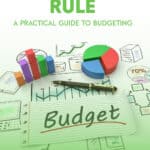The 50/30/20 Rule: A Practical Guide to Budgeting

Effective budgeting is a critical skill that can transform how we manage our money. One popular budgeting method that has gained considerable attention in recent years is the 50/30/20 budget.
The 50/30/20 budget offers a straightforward framework for allocating your income into three distinct categories, allowing you to balance your needs, wants, and financial goals.
In this article, we will dive into the workings of the 50/30/20 budget, discuss its pros and cons, and explore alternative budgeting methods like zero-sum and envelope budgeting.
By understanding the different approaches to budgeting, you can choose the method that aligns best with your financial objectives and personal preferences.
50/30/20 Budget Summary
- The 50/30/20 Rule encourages individuals to allocate their after-tax income into three categories: essential expenses, discretionary spending, and savings and debt repayment.
- It’s recommended that you set a trial period of at least two to four weeks to determine the effectiveness of a 50/30/20 budget
- Before settling on the 50/30/20 budget, consider other budgeting methods that may work as well or better for your situation, like the zero-sum and envelope budgeting methods.
What Is the 50/30/20 Rule?
The 50/30/20 rule is a budgeting technique that allocates after-tax income into three distinct categories: essential expenses (50%), discretionary spending (30%), and savings and debt repayment (20%). It was created by Senator Elizabeth Warren and her daughter Amelia Warren Tyagi in their 2006 book, All Your Worth: The Ultimate Lifetime Money Plan.
Their goal was to provide a summary view of a person’s budget for the month, helping people avoid excessive spending and accumulate savings gradually without having to document each transaction in detail.
The 50/30/20 Rule: Understanding the Three Categories
As mentioned, the three categories within the 50/30/20 rule are classified as needs (50%), wants (30%), and savings and debt (20%). “Needs” include things like rent or mortgage payments, car payments, insurance, health care, and minimum payments on debt. Variable costs such as pay-per-use utilities and groceries are also included.
“Wants” include items such as self-care, eating out, special outfits, and more expensive brands.
Contributions to a retirement fund, emergency fund, savings for homeownership or travel, or additional debt repayments are included in the “savings and debt” category.
Speaking of emergency funds, experts suggest that you try to set aside at least six months of expenses in a bank account, preferably a high-interest savings account. And retirement savings should be directed into tax-sheltered accounts, like an RRSP or TFSA.
How To Create a 50/30/20 Budget
Before you set your 50/30/20 budget, you need to calculate your net monthly income. That’s the money left over once your income tax and other payroll deductions have been removed from your pay cheque.
You should also take time to identify and categorize your expenses into needs, wants, and savings. Remember to adjust your budget to better suit your individual circumstances, and try out your new budget for the first month to make sure it’s realistic and sustainable.
If your finances are combined with a partner, I recommend combining your after-tax income together to create a budget for the household, for simplicity’s sake. Remember to include all sources of income, including any government benefits or other regular payments you receive.
Now that you’ve finished the groundwork, you’re ready to set your budget using the following three steps.
Step 1: Limit Your Needs to 50% of Your Income
Needs are expenditures that are essential for living, but it’s important to limit the needs category to 50% of after-tax income. Needs include everything from rent or mortgage payments, auto loans, and transportation costs, insurance premiums, food and household supplies, utility bills, cell phone bills, essential clothing and shoes, and minimum credit payments.
By limiting the needs category to 50% of after-tax income, you ensure that sufficient funds are available to address other expenses and to save for future contingencies.
If you’re struggling to get this budget category under 50%, consider ways that you can reduce your lifestyle. If required, could you opt for public transportation or carpooling instead of using Uber or driving your car? How about inquiring with your utility service provider about setting up equal payments? Another possibility includes downgrading your phone plan.
Step 2: Limit Your Wants to 30% of Your Income
Limiting your wants to 30% of your income in the 50/30/20 rule requires that you expend no more than 30% of after-tax income on non-essential expenditures. Examples of wants include streaming subscriptions, extra clothing and shoes, restaurants and take-out meals, travel and vacations, spa, nail, and personal care, and tickets to concerts, movies, or sporting events.
To ensure that your wants do not exceed 30% of your income (it’s not easy), identify the expenses that are not essential for survival, such as entertainment and dining out, and be very careful to manage how much you spend on those things.
Step 3: Allocate 20% of Your Income to Debt and Savings
The savings and debt reduction category should be at least 20% and includes additional debt repayments (e.g., credit card debt payments, mortgage lump sum payments, etc.), retirement contributions, and funds set aside for other savings goals.
The purpose of this category is to pay down high-interest debt while you make progress toward your savings goals.
Review Your Budget Regularly
An effective budget is only beneficial if it is followed. In order to remain within one’s budget, I recommend that you review your budget regularly to make sure that you’re expenses align with the 50/30/20 rule.
Drawbacks of the 50/30/20 Rule
The 50/30/20 rule, while providing a basic guideline for budgeting, presents certain challenges which can make it difficult to categorize spending accurately. For example, it can be challenging for individuals with a lower monthly after-tax income to adhere to the 20% savings portion of the rule, as they may struggle to meet their basic needs with just 50% of their income.
In addition, 20% savings may not be sufficient for large objectives, such as purchasing a house or retiring early. Furthermore, the 50/30/20 rule may be unrealistic for individuals with high (fixed) monthly expenses, such as those living in high-cost areas like Toronto or Vancouver or those with significant amounts of debt.
Alternatives to the 50/30/20 Budget
The 50/30/20 rule is a practical way to budget, as it promotes the allocation of a substantial portion of one’s take-home pay to savings while encouraging users to keep their spending in line. However, everyone’s situation is unique, and other budgeting methods may be more suitable for some people.
Let’s take a closer look at a couple of popular alternatives to the 50/30/20 budget.
Zero-Sum Budgeting
Zero-sum budgeting, also known as zero-based budgeting, requires you to assign a job to every dollar of income. If you’ve budgeted properly, you shouldn’t have any money left over once you’ve allocated your funds. Unlike the 50/30/20 rule, zero-sum budgeters aren’t asked to stick to specific percentages for different categories. But they are encouraged to set a new budget every interval, i.e., bi-weekly, monthly, and to be very strategic about where every dollar goes. It requires a more hands-on approach than the 50/30/20, which may or may not be a good thing.
Envelope Budgeting
Envelope budgeting is a method where you allocate cash to different envelopes for various categories, such as groceries, entertainment, and transportation. This method differs from the 50/30/20 rule in that it necessitates the use of cash and the allocation of specific amounts to each category rather than simply a percentage.
The zero-sum budgeting method, envelope budgeting method, and the 50/30/20 rule all have their own advantages and disadvantages that should be considered before you decide which budgeting method is best for you.
Frequently Asked Questions
Does the 50/30/20 rule work?
The 50/30/20 rule is an effective way to budget and manage one's finances because it sets a clear division of resources. It offers a practical framework that can easily be adjusted to fit the individual needs of each person. It has proven to work successfully for many people, making it a widely accepted approach in personal finance management.
Why is the 50/30/20 rule so effective?
The 50/30/20 rule is a good budgeting tool because it helps individuals create an achievable plan for managing their finances responsibly, and balancing their needs, wants, and savings in a proper manner. It provides a framework for regularly evaluating spending habits and encourages you to make adjustments to ensure that goals are met more quickly.
Can you adjust the percentages of the 50/30/20?
Some people may find that the 50/30/20 category weightings don't work for their individual situation. Perhaps their fixed expenses are higher due to living in a high-cost-of-living area, or the opposite is true, and they can allocate a higher percentage to savings. That's perfectly fine. However, if you are unable to allocate at least 20% to savings and debt repayment, consider how you may be able to reduce your expenses or increase your income to increase your savings rate in the future.
Final Thoughts on the 50/30/20 Budget
It’s important to remember that the best budgeting approach is the one that resonates with you and aligns with your long-term financial aspirations. While the 50/30/20 rule provides a structured framework for managing your finances, it might not be the perfect fit for everyone. That’s why I mentioned alternatives like zero-sum and envelope budgeting.
My advice is that you explore all options, experiment with different approaches, and choose the budgeting method that propels you toward a brighter financial future.

